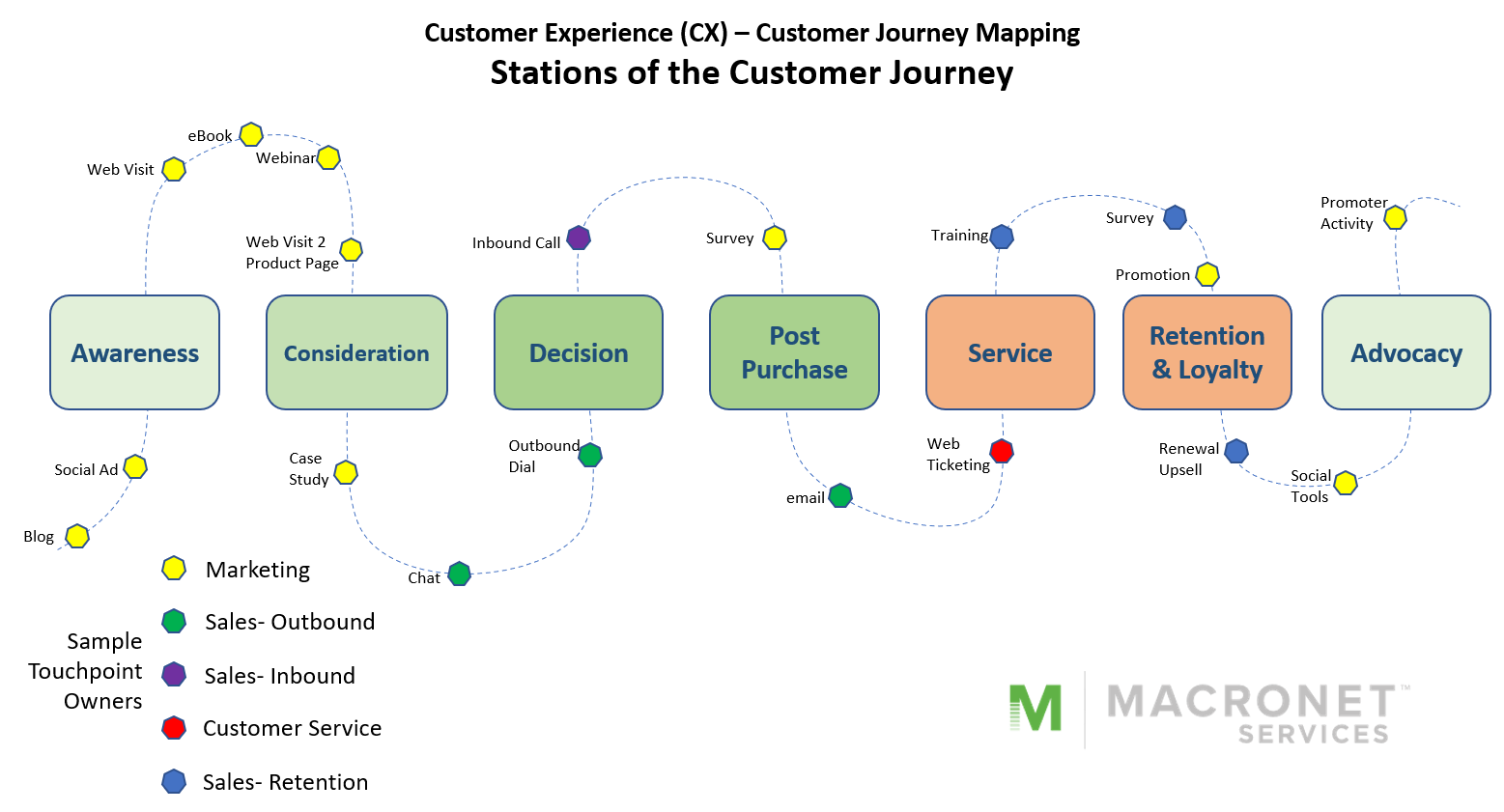Contact Center Strategies for 2023
The contact center is the primary point of interface for your customers to your brand and often will shape permanent impressions, good or bad. Therefore, it’s critically important for stakeholders across the business to participate in short-term and long-term contact center strategies.
The modern contact center leverages the benefits of cloud communications and the pace of advancement in CCaaS (Contact Center as a Service) technology has amplified exponentially in recent years. You can be positioned to quickly roll out enhancements, but this requires a defined strategy.
The team at Macronet Services represents a long list of leaders in CCaaS and has a strong team of contact center consultants, which gives us excellent visibility into contact center trends and technologies and how to shape strategies that drive competitive advantages that are specific to each of our clients.
The following list includes strategies that should be considered to build a culture of continuous improvement for your contact center.
- Define your Contact Center optimization team
As we noted in the opening, stakeholders from across the business should participate in the success of the contact center, and hereby, your customer experience (CX). The IT organization obviously plays a critical role in evaluating, implementing, and operating technology for the business. CCaaS is a great area for IT to play a lead role in governing a committee of stakeholders across sales, marketing, customer support, operations, and finance (for example) to ensure that the customer journey is continuously improved. Having a committee in place with defined roles is critical when it comes time to make major changes such as sourcing a new CCaaS platform supplier.
- Customer Journey Mapping
In January of 2022, we posted an article entitled “Contact Center Consultant and the Customer Journey”. The content will continue to be highly relevant well into the future. In summary, your prospects and customers will seek to have touchpoints with your business at all stages of the customer lifecycle and regularly mapping the customer journey is key to maintaining an exceptional customer experience at any point in the customer lifecycle. Operational planning and technology plug-ins can lead to positive outcomes and ideally, to stages of loyalty and even advocacy for your product. The contact center governance committee should ensure that constant attention is paid to customer journey mapping and all potential touchpoints.

- Identify and prioritize must-have CCaaS features for each business case
Today’s CCaaS leaders promote a very long list of CCaaS offerings on their web sites and may seek to bundle as many as possible in the initial sale. Also, contact center committee members might push for all the next gen features that they have been longing for. Often this can lead to sticker shock and in some cases, project delays due to budget concerns or due to projects that are overly extensive in scope for the team to deploy. Each new feature may have a clear business case that needs articulation. For example, its likely that the use of a virtual agent will generate clear cost savings by offloading simple actions, availing expensive personnel resources to interface with your customers.
- Optimize for Omnichannel
The Omnichannel contact center enables your customers to initiate touchpoints with your business via voice, mobile, email, chat, social, SMS/text, and even video. Expanding the customer experience to open these channels might seem complex, but todays CCaaS platforms can simplify the deployment. IT needs to consider how Omnichannel extends beyond contact center and into payment systems. Recent advancements omnichannel commerce hub technology includes numerous pre-built integrations and machine learning AI to integrate multiple systems.
- Evaluate Workforce Optimization
Workforce optimization (WFO) in the contact center product is a suite of tools designed to improve employee efficiency. Many of the leading CCaaS providers offer native WFO tools and have enabled integrations with numerous best-of-breed tools. Some of the key WFO features to analyze include workforce management (scheduling), interaction analytics, performance management, CRM integration, quality management, and interaction recording. Again, it is important to prioritize the tools and features that are right for your business and to determine if a native solution, or a third-party integration, is the right solution for your CCaaS platform.
- Leverage Intelligent Virtual Agents for Self Service
Intelligent virtual agents (IVA) use advanced conversational AI technology to enable self-service applications. Surveys have shown that customers appreciate the ability to solve for simple issues and common questions by using an intuitive and responsive tool rather than talking to a live agent. In our March 2022 article “Why you need an intelligent virtual agent in your contact center” we explain the benefits and business case for offloading simple tasks to an IVA. Technology indicators show that virtual agent technology will advance exponentially and should be carefully considered in 2023.
- Revisit your HR strategy
The modern CCaaS platform allows your contact center representatives to sit virtually anywhere in the world where they can access a quality internet connection. When combined with WFO tools, supervisors can schedule in a full-time staff of high qualified support professionals that are passionate about your products and services. Further, some CCaaS platforms enable seamless transfer to other experts across your organization. Additionally, HR should consider how coaching tools and gamification can be used to create a culture that promotes higher job satisfaction ratings and bottom-line revenue.
- Focus on Gamification
In August of 2021 we posted an article on Gamification that covered the benefits to propelling your contact center personnel into a state of flow by using gamification tools. Even since our article, leading CCaaS vendors and third-party developers have built new and exciting tools that will soon be commonplace in the contact center. Many studies have shown how the self-determination theory can be sparked by some friendly competition – and you can tie the goals to business KPIs.
- Integrate with UCaaS
Several of the leading CCaaS providers also have complete UCaaS (Unified Communications as a Service) offerings integrated into their platform. UCaaS can replace a global mix of phone systems with a seamless communications platform, which can be integrated into the global contact center. Macronet Services has years of experience with global UCaaS deployment projects and can help to determine the best path for integrating CCaaS and UCaaS across your organization
- Execute a Contact Center RFP process
Building a contact center Request for Proposal can be a daunting task but it’s critical to ensure that your contact center committee achieves a level of competency with the products and services that are available in the marketplace. The team at macronet has a CCaaS RFP Download that can serve as a template. Our team can guide you through the complete design and sourcing process.
We how that this article has given you some food for thought toward your contact center planning. We represent all the leading Contact Center as a Service providers and welcome a conversation to discuss how we can help leverage contact center technology to make your business more competitive and profitable. Contact us anytime.
Related Posts
3 Comments
Comments are closed.
Recent Posts
- How Laser Satellite Communication Breakthroughs Compete with Starlink
- AI-Powered Humanoid Robots: Transforming Business, Homes & Connectivity
- Top IT & Network Design Consultants in Boston and New England: Macronet Services
- Top AI Consultants in New England: Why New Hampshire’s Macronet Services Shines in Boston and Beyond
- IXPs in the US and Internet Peering
Archives
- July 2025
- June 2025
- May 2025
- April 2025
- March 2025
- February 2025
- January 2025
- December 2024
- November 2024
- October 2024
- September 2024
- August 2024
- July 2024
- June 2024
- May 2024
- April 2024
- March 2024
- February 2024
- January 2024
- December 2023
- November 2023
- October 2023
- September 2023
- August 2023
- July 2023
- June 2023
- May 2023
- April 2023
- March 2023
- February 2023
- January 2023
- December 2022
- November 2022
- October 2022
- September 2022
- August 2022
- July 2022
- June 2022
- May 2022
- April 2022
- March 2022
- February 2022
- January 2022
- December 2021
- November 2021
- October 2021
- September 2021
- August 2021
- July 2021
- June 2021
- May 2021
- April 2021
- March 2021
- December 2020
- September 2020
- August 2020
- July 2020
- June 2020
Categories
- All (19)
- Satellite (1)
- Artificial Intelligence (3)
- Travel (1)
- Sports (1)
- Music (1)
- News (271)
- Design (3)
- Clients (12)
- Uncategorized (1)
- Tips & tricks (25)
- Inspiration (9)
- Client story (1)
- Unified Communications (196)
- Wide Area Network (308)
- Cloud SaaS (60)
- Security Services (71)





[…] generally need some sort of Call Center. UCaaS enables you to move to the same concept called a Contact Center and yes, it’s as a Service. Similar to the legacy PBX, Contact Centers are phased out providing […]
[…] phone system integration to Teams should equally be part of your Contact Center Strategy well into 2023. […]
[…] Contact Center. Not just in Contact Center, but voice overall especially if your company has legacy POTS services which should understand the new FCC guidelines on FCC-192. This relieves the requirement of local telecom carriers providing traditional copper POTS services. Telecom Consultants will look to implement a new service across offices especially for Life Safety lines needed for fire and burglar communications. […]